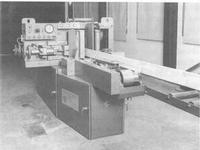


Chapter 4
I Management Of Native Forests
II Plantations-high Productivity Resources
III Protecting The Resource
IV Harvesting The Resource
V Solid Wood And Its Processing
i Sawmilling
ii Drying
iii Preservation
iv Quality and standards
VI Minor Forest Products
VII Reconstituted Wood Products
VIII Pulp And Paper
IX Export Woodchips
X Future Directions
XI Acknowledgements
References
Index
Search
Help
Contact us

Quality and standards
Little was known of the mechanical properties of Australian woods until Professor W. H. Warren at the University of Sydney in the late 1880s, having undertaken tests for a Royal Commission enquiring into railway bridge safety, extended his investigation to measure the strengths of all major NSW woods as well as many from other States.[61] This study, together with others that followed, provided valuable data and helped dispel doubts that had arisen earlier because of inaccurate reports of the strengths of the native timbers. Despite the increasing knowledge of their intrinsic value, however, their presentation as sawn wood on the local market for many years left much to be desired, particularly because of variable quality and poor drying.The first steps towards standards for the timber industry were made in 1930, when the Standards Association of Australia set up a Timber Sectional Committee which sought first to establish definitions for the wide variety of trade terms and standard trade names for specific timbers. Shortly thereafter the Forests Department of Western Australia and CSIR jointly developed visual grading rules for jarrah to ensure that timber of acceptable and uniform quality could be supplied for any specified major end use.[62] By the late 1930s CSIR had developed a system to classify the more common Australian and imported timbers into four strength groups[63] on the basis of an extensive testing program and C. J. J. Watson of the Queensland Forest Service had made a comprehensive study on North Queensland woods to classify them for building purposes according to their durability and strength.[64] The SAA committee developed its first standard grading rules for timber (for flooring) in 1939. The knowledge gained on the mechanical properties of Australian woods also enabled new design data to be developed by CSIR and this was published in 1939 by Langlands and Thomas in a Handbook of Structural Timber Design which became a standard reference work.[65] During the Second World War it was found possible on the basis of CSIR's work to introduce a reduction in standard timber sizes for domestic housing to conserve resources.[66]
The number of strength groups into which Australian timbers were classified was increased from four to seven in the 1960s, in part to enable the inclusion of plantation pines and overseas timbers. A stress grading system was also introduced which designated the grades with numerical 'F' values (equivalent to the typical basic working stress in bending for the grade in megapascals) instead of the descriptive terms used earlier.[67] While stress grading could be done on the basis of visual inspection and knowledge of the strength group to which the timber belonged, interest developed in mechanical grading because of its potentially better accuracy. This led in the mid-1960s to the development by the Wood Technology Division of the Forestry Commission of NSW, working together with Plessey Aust. Pty. Ltd., of the 'Computermatic' machine stress grader which became widely used in Australia and overseas.[68] The machine measures the stiffness of a sample from its deflection under a standard load and thus requires a knowledge of the correlation between this and strength. In the 1970s CSIRO pursued a simpler and more direct method of strength assessment which tests the ability of a sample to withstand a predetermined bending load similar to that which it will meet in use.[69] Machines based on this 'proof grading' principle have now also been developed and are in commercial use.[70]

Organisations in Australian Science at Work - CSIRO Division of Forest Products; N.S.W. Forestry Commission; Plessey Aust. Pty Ltd; Queensland Forest Service; Standards Association of Australia. Timber Sectional Committee; Western Australia. Forests Department
People in Bright Sparcs - Langland, I.; Thomas, A. J.; Warren, Prof. William Henry; Watson, C. J. J.
 |
Australian Academy of Technological Sciences and Engineering |  |
© 1988 Print Edition page 224, Online Edition 2000
Published by Australian Science and Technology Heritage Centre, using the Web Academic Resource Publisher
http://www.austehc.unimelb.edu.au/tia/234.html